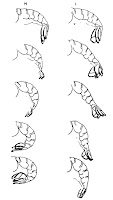 This particular picture is not famous outside of my own field. But it has been reproduced many times, and as such, I think warrants the classic designation.
This particular picture is not famous outside of my own field. But it has been reproduced many times, and as such, I think warrants the classic designation.Crayfish tailflipping was one of the first natural animal behaviours that neuroethology really cracked. It was one of the first cases where we could explain how the connections between the neurons explained a lot about how the behaviour of the animal worked.
One of the little oddities in the story of understanding the escape response of crayfish was that the major neurons involved were recognized back in the 1920s. These huge neurons became known as the lateral giant (LG) and medial giant (MG) neurons, but even in the flapper era, there was pretty strong evidence then these giant neurons were involved in tailflipping.
But it took over 40 years for people to explain why there were two sets of neurons involved in tailflipping. And they can be forgiven for not figuring this out quickly, because this behaviour is so blindingly fast, you can't make it out with the naked eye.
When people finally got around to using high speed film, the answer became clear. There wasn't one behaviour. There were two. There were two different kinds of tailflips, each triggered by a different set of neurons. (Actually, it turned out that there were three kinds of tailflips, but that's another story.)
What fascinates me about this particular figure (from Wine and Krasne, 1972) is that it was not the first to make this point. Priority is huge in science. Normally, the first to show anything gets priority, and hold a very strong sway on our imaginations. Ask someone who was the second person to climb Mount Everest, or the second person to fly solo across the Atlantic. Heck, I don't know.
 Just a few months earlier, in the same journal, another group of researchers led by Jim Larimer (which included my intellectual predecessor, Don Kennedy) published a picture that shows the same thing: that stimulating the different neurons generates different movements.
Just a few months earlier, in the same journal, another group of researchers led by Jim Larimer (which included my intellectual predecessor, Don Kennedy) published a picture that shows the same thing: that stimulating the different neurons generates different movements.In this case, I think it's pretty clear why the later picture became the canonical representation of crayfish escape behaviour: context. You see the stick tapping animal, and you see the whole animal, moving through space, rather than an isolated part of an animal being held static. The advantages of this are huge.
The top diagram makes it forcefully clear what advantage there is to having two tailflips: both tailflips take the animal away from the source of the offending stimulus, but do so by throwing the animal in different directions. The crayfish jackknifes into the water when the LGs fire, but heads straight back when the MGs fire. You can sort of extrapolate that from what's shown in the earlier figure, but since you can't see where the stimulus would be, you don't have that immediate "Aha!" insight.
Sometimes, it isn't better to be first. It's better to be better.
References
Larimer, J. L., Eggleston, A. C., Masukawa, L. M. and Kennedy, D. (1971). The different connections and motor outputs of lateral and medial giant fibres in the crayfish. The Journal of Experimental Biology 54, 391-404.
Wine, J. J. and Krasne, F. B. (1972). The organization of escape behaviour in the crayfish. The Journal of Experimental Biology 56, 1-18.

No comments:
Post a Comment